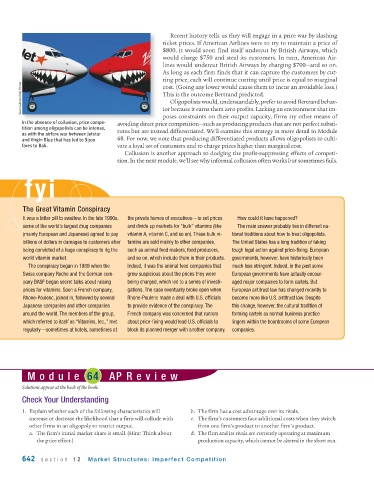Page 684 - Krugmans Economics for AP Text Book_Neat
P. 684
Recent history tells us they will engage in a price war by slashing
ticket prices. If American Airlines were to try to maintain a price of
$800, it would soon find itself undercut by British Airways, which
would charge $750 and steal its customers. In turn, American Air-
lines would undercut British Airways by charging $700—and so on.
As long as each firm finds that it can capture the customers by cut-
ting price, each will continue cutting until price is equal to marginal
Sean Callinan/Rob Homer This is the outcome Bertrand predicted.
cost. (Going any lower would cause them to incur an avoidable loss.)
Oligopolists would, understandably, prefer to avoid Bertrand behav-
ior because it earns them zero profits. Lacking an environment that im-
poses constraints on their output capacity, firms try other means of
In the absence of collusion, price compe- avoiding direct price competition—such as producing products that are not perfect substi-
tition among oligopolists can be intense,
as with the airfare war between Jetstar tutes but are instead differentiated. We’ll examine this strategy in more detail in Module
and Virgin Blue that has led to $300 68. For now, we note that producing differentiated products allows oligopolists to culti-
fares to Bali. vate a loyal set of customers and to charge prices higher than marginal cost.
Collusion is another approach to dodging the profit-suppressing effects of competi-
tion. In the next module, we’ll see why informal collusion often works but sometimes fails.
fyi
The Great Vitamin Conspiracy
It was a bitter pill to swallow. In the late 1990s, the private homes of executives—to set prices How could it have happened?
some of the world’s largest drug companies and divide up markets for “bulk” vitamins (like The main answer probably lies in different na-
(mainly European and Japanese) agreed to pay vitamin A, vitamin C, and so on). These bulk vi- tional traditions about how to treat oligopolists.
billions of dollars in damages to customers after tamins are sold mainly to other companies, The United States has a long tradition of taking
being convicted of a huge conspiracy to rig the such as animal feed makers, food producers, tough legal action against price-fixing. European
world vitamin market. and so on, which include them in their products. governments, however, have historically been
The conspiracy began in 1989 when the Indeed, it was the animal feed companies that much less stringent. Indeed, in the past some
Swiss company Roche and the German com- grew suspicious about the prices they were European governments have actually encour-
pany BASF began secret talks about raising being charged, which led to a series of investi- aged major companies to form cartels. But
prices for vitamins. Soon a French company, gations. The case eventually broke open when European antitrust law has changed recently to
Rhone-Poulenc, joined in, followed by several Rhone-Poulenc made a deal with U.S. officials become more like U.S. antitrust law. Despite
Japanese companies and other companies to provide evidence of the conspiracy. The this change, however, the cultural tradition of
around the world. The members of the group, French company was concerned that rumors forming cartels as normal business practice
which referred to itself as “Vitamins, Inc.,” met about price-fixing would lead U.S. officials to lingers within the boardrooms of some European
regularly—sometimes at hotels, sometimes at block its planned merger with another company. companies.
Module 64 AP Review
Solutions appear at the back of the book.
Check Your Understanding
1. Explain whether each of the following characteristics will b. The firm has a cost advantage over its rivals.
increase or decrease the likelihood that a firm will collude with c. The firm’s customers face additional costs when they switch
other firms in an oligopoly to restrict output. from one firm’s product to another firm’s product.
a. The firm’s initial market share is small. (Hint: Think about d. The firm and its rivals are currently operating at maximum
the price effect.) production capacity, which cannot be altered in the short run.
642 section 12 Market Structures: Imperfect Competition

